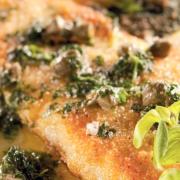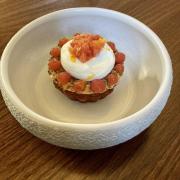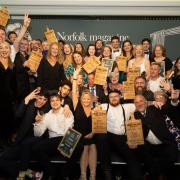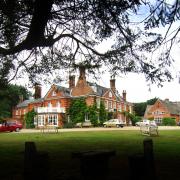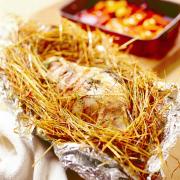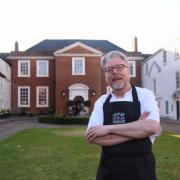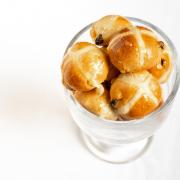Most of us learned about the Tudors at school but perhaps only Brigitte Webster became so fascinated that she lives in a Tudor house, is recreating a Tudor garden and has built a career out of her expertise in Tudor food.
Her love of the recipes and ingredients of 16th century England has brought her from a childhood in Austria to a Tudor manor house in Barnham Broom, near Norwich.
Here she plans to invite guests to enjoy a taste of life as a Tudor – with the emphasis on Tudor food, much of it grown in her own garden.

While she works towards launching her Tudor home stays, everyone can get a taste of the kind of food Brigitte plans to cook and serve from her new book Eating with the Tudors, an illustrated history of the food with recipes.
It was studying the Tudors during English lessons in her native Austria which sparked her life-long interest in the monarchs and their food. She went on to teach cookery and history (and then German when she moved to the UK with her English husband Tom.) ‘But I always tried to smuggle a bit of cookery and history into my classes!’ she said.
Eight years ago she left teaching to focus on food history and has since appeared on Suzannah Lipscomb’s television series Walking Tudor England, discussed Tudor banquets on Suzannah’s podcast and given talks on Tudor food, including at Henry VIII’s Hampton Court Palace.

She began work on Eating with the Tudors after searching for a cookery book which featured Tudor recipes alongside modern versions, and also included information on the history of the ingredients and dishes.
Unable to find the book she needed, she decided to write it.
Structured around the seasons, it includes dishes for Tudor fast days and feast days, and food for picnics, preserves and presents. Each section finishes with beautifully illustrated recipes.

‘Tudor dishes and recipes never fail to surprise and amaze me,’ she said. ‘I have only very occasionally not enjoyed what I have cooked. More often I found that a recipe which sounded less-than-appetising turned out to be surprisingly appealing.
‘Early Tudor recipes have a certain North African flair about them – mixing a savoury meaty dish with sweet, dried fruit, and there is something for everyone: the meat lover, the vegetarian, the sweet tooth and the salad enthusiast.’
She said Tudor cooks made great use of native seasonal produce and her own favourite recipes vary with the seasons.
At this time of year she loves making a 16th century recipe. ‘It produces the most wonderful apple pie you will have ever tasted!’ she said.

Brigitte pored over household account books, manuscripts, letters, wills, diaries and writings by Tudor doctors and herbalists to find out about what people ate in the 16th century.
Her research took her to Holkham Hall in north Norfolk where she studied early recipes from its library. One collection of recipes began with menus for royal feasts, describing how to cook meat, fish, sauces, stews and pies – but with more emphasis on how to slaughter animals for the meat than measuring ingredients or giving cooking instructions.
She said Tudor recipes were aimed at cooks who were already proficient. ‘Anybody who first glances at an original early Tudor recipe may be forgiven for abandoning the will to recreate an authentic dish!’ she said. ‘The text offers no list of clear ingredients, measurements or ordered approach of instructions.’

Her new book fills in many of the missing details so that people can recreate more than 100 Tudor dishes including cheese, egg and elderflower fritters, salmon with onions and violets, roast venison, stewed pigeon, baked pork, boiled mutton, fried turnips, pickled samphire salad, baked chicken with damsons, quince pies and cherry tarts.
Some Tudor favourites have already seen a resurgence in popularity. ‘Pear in spiced wine is one,’ said Brigitte. ‘And meaty pies, in particular venison and game. And serving fresh leaf salads with a dressing.
‘Another Tudor trend re-invented is to decorate dishes with fresh flowers.’
Her book is illustrated with beautiful pictures of petal-strewn sauces and roasts, glossy jewel-coloured fruit tarts.

However there are some Tudor meals which Brigitte definitely would not serve. ‘Wealthy Tudors would have eaten porpoise and seals,’ she said. ‘Peasants had to eat stockfish (dried and rock-hard fish). None would find any takers today.’
Brigitte also uncovered some Tudor table manners which would raise eyebrows today.
‘At a communal dining table, up to four people would share the same plate, known as a mess,’ she said.
She also revealed that Tudors did not use forks and took their own knives when invited to another house for dinner – but spoons were supplied by the host.
She has used a modern kitchen, complete with full sets of cutlery, to recreate Tudor recipes, and particularly appreciates her food blender, and ingredients such as icing sugar and butter.
Tudor cooks had to use sieves instead of blenders, pound sugar down to the correct consistency for icing, and make their own butter.

However, Brigitte does cook seasonally and from scratch as much as possible. ‘For hard-to-get ingredients, such as perhaps iconic Tudor vegetables skirret or salsify (both root vegetables) I grow them in my garden,’ she said. Other plants in her Tudor garden include kale, cabbages, leeks, onions, garlic, parsnips, turnips, spinach, radishes, cucumbers, pumpkins, peas, carrots, globe artichokes, asparagus and herbs.
She has created her Tudor garden in the grounds of the home she and Tom moved into four years ago, after first launching Tudor gastronomic breaks, offering bed and board, cookery classes, and Tudor dance, sport and entertainment sessions, while living in Hertfordshire.
The house dates back more than 500 years, with another wing added in 1614. It once had a drawbridge and includes a chapel with linked bedroom for a resident priest. The south wing doubled as the village rectory in the early 19th century. But by the mid 20th century the 1614 Jacobean parlour, with one of the most magnificent plaster ceilings in the country, was being used to store hay and fencing.
Subsequent owners restored the beautiful house and Brigitte, and Tom who is an expert in Tudor military history, have held Tudor open days and hope to relaunch their Tudor and 17th Century Experience in 2025.
In the meantime Brigitte is already working on her second book, about creating a Tudor garden.
Eating with the Tudors, an illustrated history of the food with recipes, by Brigitte Webster, is published by Pen and Sword.












